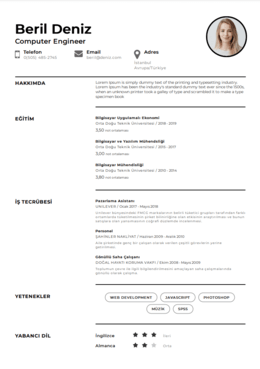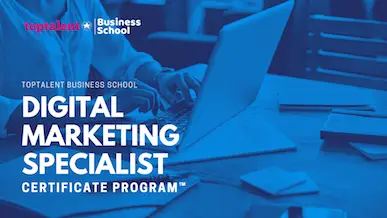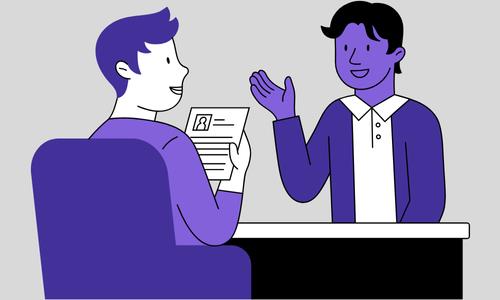Resume Help Zeynep İclal Akçakoca
How to Start a Resume: Guide with 15+ Starters & Tips
Yeni CV örneklerini inceleBefore we discuss how to start a CV, think about the following:
You've finally found it after searching for days: your ideal job, complete with fantastic benefits, an understandable schedule, and duties you can be proud of.
Simply begin crafting a resume is all that is required.
And here you are, unable to move past staring at the blinking cursor on your screen.
Questions begin to pour in. How should I begin a resume? What excellent resume openings are there? True or false: Your resume should always open with the words "resume" at the top?
Relax. We'll demonstrate how to launch your resume effectively. in stages. You'll soon be well on your way to crafting the ideal CV that will land you the job.
In this resume tutorial, the following topics will be covered:
- How to get the recruiter's attention and make you the top priority on your CV.
- Examples of the strongest resume sentences that will hook hiring managers.
- How to begin a CV with no prior work experience is best (or with just a little).
- How to begin creating a resume that is superior to the work of the competition.
Here is an example of an IT specialist resume created with our resume creator.
Would you like to cut down on time and have your resume ready in 5 minutes? Use our resume generator. It is quick and simple to use. In addition, ready-made content is available for quick addition. Create your resume using one of the 20+ templates offered.
To Start, Focus on the End
Therefore, you want to start the CV off strongly so that the hiring manager calls you. Or maybe you're having trouble getting started on the resume from scratch.
Do not worry; we will demonstrate how to do both.
As you can see, the heading is the greatest place to start a resume. That is what might hook hiring managers.
But now for the surprise. That heading—the resume summary or objective—must be the final item you write for it to have the greatest impact. So let's concentrate on how to actually begin producing a resume.
1. Save and Open the Original Job Description
How do I create a resume? Review the original job posting once more before you begin crafting your resume. Keep it. Keep it open while you draft your cover letter and resume.
This is why:
- Depending on the job description and your background, you should utilize a resume summary rather than an objective statement (that section we moved to the end).
- The precise curriculum mentioned in the job description may be helpful for the education section.
- The most crucial resume keywords will be determined by the job description.
- It might also provide additional details or writing tips for your cover letter and CV.
2. Prepare a Resume Outline
Let me venture a guess. You ran into a wall as soon as you attempted to add your contact information to the resume, which shows that you have no idea where to begin.
Before you can begin creating your CV, you must complete the following second step. Create a resume summary first.
An outline for a resume is more than simply a rough draft.
- It makes sure you didn't overlook any important details.
- It enables you to plan out the layout of your resume.
- It improves the precision of your resume.
Recruiters scan each resume for an average of 7 seconds, according to our HR analytics study. Therefore, a resume summary is essential to give the recruiter all the information they need to know about their ideal candidate—you.
3. Choose the Perfect Format
Before you begin writing your resume, there is one more step you might need to complete: selecting the appropriate resume format.
There are three typical forms for resumes:
The reverse-chronological resume style works best for the majority of job searchers. One size fits all applies here. By beginning with your most recent position and moving backward from there, it displays your professional background.
The combo resume format could be advantageous for some people. It's for those who wish to demonstrate their abilities before diving into their employment. It's the best resume structure for high-level professionals or those changing careers. It's a fantastic resume structure as well for job seekers with gaps in their employment.
4. Start Writing the Actual Resume (Experience Section)
The job history in the experience section would be the main course if the resume were a meal in and of itself.
Have any experience?
You start with your most recent job and work your way backward in reverse chronological order.
We'll identify your most recent position, dates held it, city, state, and nation, as well as a bulleted list of responsibilities and accomplishments you'll choose carefully to impress the hiring manager, as seen on this sample chef resume:
Chef
January 2013 - December 2016
South Street Lobster House, New York, NY
Key Chef Responsibilities
- Trained prep and line cooks on changing menu items.
- Encouraged wait personnel to have a say in dessert pairing choices depending on menu and taste.
- Created a covert, anonymous survey that other restaurants quickly imitated to determine the demand for new menu items.
Key Chef Achievements
- Discovered a management strategy for the lobster tanks that resulted in a 17 percent reduction in cooking time.
- Reduced the restaurant manager's workload by 39% by helping with employee administration applications.
See that? This sample resume starts each sentence with a verb. Action verbs are excellent sentence starts for resumes.
No or Little Experience?
It could be ideal if you start with the schooling portion if you lack any work experience.
If you have little to no experience relevant to the position for which you are seeking, you should emphasize your most pertinent qualifications and accomplishments from prior positions, or even use the previously described combination structure.
5. Move on to Your Education Section
Do you believe the schooling part is only included to lengthen your resume?
Think again. The majority of hiring managers demand information about your schooling on a resume. Many job postings also specify the required level of education. It's an important step in creating a CV.
So, when considering how to create the greatest resume, don't forget to include education.
As you are putting together a resume, remember to include the following components to create a comprehensive education entry:
- Name and location of the university ,
- Major and degree
- Awards, honors, and GPA
Are you still a student and pursuing a degree? Not to worry!
Maintain the same formatting as before, but also include a line for the "anticipated completion date."
If you're unsure of how to begin a resume for a teenager or high school student, use these general formatting guidelines, but exclude the information about your high school if you have further schooling to offer.
Drag and drop skills and bullet points into your resume using our builder, and let the tedious information auto-fill. Use spellcheck. Check. Create a professional resume template right now for nothing.
6. Finish it Off with Other Section
Let's keep the momentum rolling now that your resume is off to a wonderful start.
Once you've completed these steps for starting a resume from scratch, there are a few more to take in order to complete the process:
Skills Section
Even though the talents portion of your resume frequently takes up little space, it has a significant influence. Want to learn more about creating a skills section for a resume?
Additional Sections
Although the other sections on your resume can differ, they unquestionably make you stand out from the competition. Volunteer experience, credentials, interests & hobbies, language skills, and more may be added as sections.
Cover Letter
In cover letters, you can take a much-needed break from the jargon and technical language and really show off your human side.
7. Use a Heading Statement to Give Your Resume a Head Start
“The Beginning Is the End Is the Beginning.”
If you followed all of the instructions above, you have already begun creating a resume and are nearly finished! It's time to start drafting the résumé and finish it now.
Recruiters will begin reading the header statement first. For a recruiter, it is the crucial first impression and the deciding factor.
The heading statement serves as the resume's introduction. It can take the shape of a resume aim or summary.
Start a Resume with a Summary
If you're applying for a position at a company where you already have experience, select the resume summary. Your qualities and skills for the post are summed up in the resume summary.
Start a Resume with an Objective
If you don't have any work experience, or at least none that is relevant to the position you're looking for, use the resume objective.
Instead, you'll emphasize your transferrable talents from other fields and argue that even though you lack experience for this position specifically, you do have the experience that is pertinent to it.
Now that we've completed the circle, the beginning of your resume is the focus of the article's conclusion. And look at that, please! You've finished the whole job by figuring out how to start a resume off strong.
It wasn't all that bad, was it?
Key Takeaway
What did you think, then?
You should be well on your way to finishing a resume you will be proud of after reading these resume starting suggestions and guidance.
- Making a resume - Adding more tasks at the start of a resume may appear terrible. However, you may ensure that you do it correctly by beginning a resume with an overview and selecting the appropriate format.
- Starting a resume introduction correctly can make or destroy your chances of being hired. It makes the first impression, so you'll want to write one that will get their attention right away and start strong.
- Experience and education - Now that you are aware of how to construct a resume's experience and education section, you have set the stage for a solid resume that will undoubtedly land you interviews.
Do you have any concerns about where to begin a CV for a job? Need advice on how to create a résumé or how to make one appear good? We'll respond if you ask a question in the comments section below. Gratitude for reading!
















































